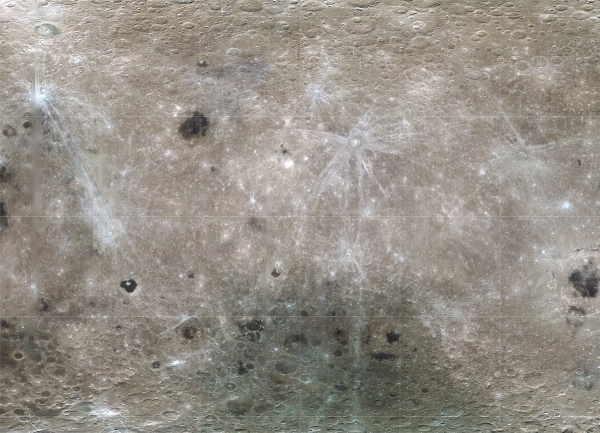
One of my all-time favorite space images is this little gem from the Clementine mission to the Moon, launched in January of 1994. It features a view from beyond the far side of the Moon, illuminated by reflected light off the Earth off frame to the left, blocking the disc of the Sun with the solar corona and Venus shining brightly in the background. Absolutely stunning!
The image above was taken by one of the two Star Tracker navigation cameras aboard the Clementine spacecraft. Clementine also had a suite of much more sophisticated cameras aboard to map the surface of the moon in a wide range of wavelengths; for example, the image below shows a map of the lunar farside made of a mosaic of tens of thousands of Clementine UVIS images:

Clementine also captured this amazing image of an “Earthrise” over the Moon’s north pole:

Clementine was a joint NASA and Ballistic Missile Defense Organization mission to map the lunar surface and then the 3-mile-wide near-Earth asteroid Geographos. After leaving lunar orbit, a malfunction prevented Clementine from completing the second portion of its mission. Even though it never succeeded in reaching the asteroid the vast amounts of multi-spectral digital data from the pole-to-pole lunar mapping portion prompted President Bill Clinton to dub Clementine a major national achievement in aeronautics in space. The Clementine mission was inducted into the Space Hall of Fame in 1996.
Learn more about Clementine here and see more images from the mission here.
Image credit: NASA/JPL/USGS
This has always been one of my favorite images.
I didn’t get the reference in the headline at first, but now I can’t get the song out of my head. Bastard.
LikeLike
Dreadful sorry….
LikeLike
Hey, check out these too:
http://www.cmf.nrl.navy.mil/clementine/clem_collect/earth_moon.html
http://www.cmf.nrl.navy.mil/clementine/clem_collect/orient.html
LikeLike
Those are fantastic too. Great images! (Awful logo.)
LikeLike
That first image is very cool, but there’s something about the Earth’s color that makes it look weird and artificial. Maybe it’s the filter choice or maybe it’s just me.
LikeLike
Yeah, it’s fake. “Colorized” I think is the term they used.
LikeLike
It does look a little like a Shrinky-Dink.
LikeLike
D’oh!
Maybe next time I could actually… you know, *read* the image description!
I always figured it was an infrared filter involved or something, never realized it was colorized.
LikeLike
Why is Venus shining if it’s between the moon and the sun? Shouldn’t be a dull dark spot since the sun’s light isn’t shining on it (like when we see it from earth)?
LikeLike
While Venus *could* have been on the other side of the Sun when this image was taken (I don’t know the positions of the planets on that date) even a crescent Venus would have been bright enough to bloom out in images captured by Clementine’s Startracker camera. So it’s hard to tell which is which. Unless Venus was literally eclipsing the face of the Sun it wouldn’t have appeared as a dark spot.
LikeLike
After looking this up using the Solar System model at http://www.fourmilab.ch/cgi-bin/Solar, I see that Venus in Jan. 1994 was never nearer to Earth than the Sun. So thus is was considerably well-illuminated. Post edited to not say “between.”
LikeLike
Reblogged this on OODOO.
LikeLike